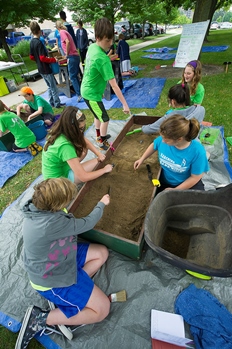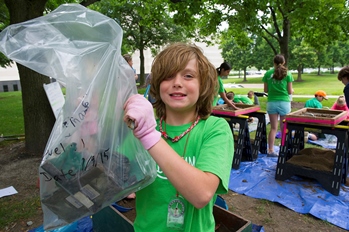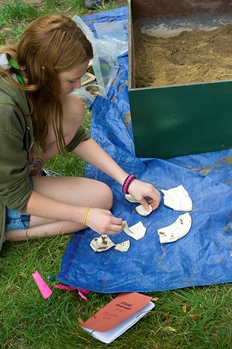Showcasing the DNR: Kids dig learning at archaeology camp
Michigan Department of Natural Resources sent this bulletin at 07/17/2015 05:13 PM EDT|
Second-year program gains in popularity, infuses learning with fun, exploration and dirt! |
 |
 |
 |
Showcasing the DNR
Youngsters learn the basics of archaeology at Dig Camp
Kids dig digging. So the Michigan Historical Museum gave a number of them the opportunity to spend a week hanging out with professional diggers.
No, not heavy equipment operators or agricultural workers. Archaeologists.  The museum, located in the Michigan Historical Center on the state government campus in downtown Lansing, put on a pair of “Dig Camps” this summer – weeklong plunges into the world of archaeology. Eighteen 8- to 10-year-olds, and 15 11- to 13-year-olds spent a week at the center learning about what archaeologists do, and don’t do.
The museum, located in the Michigan Historical Center on the state government campus in downtown Lansing, put on a pair of “Dig Camps” this summer – weeklong plunges into the world of archaeology. Eighteen 8- to 10-year-olds, and 15 11- to 13-year-olds spent a week at the center learning about what archaeologists do, and don’t do.
“We tell the kids that we don’t do dinosaurs,” said Dean Anderson, the state archaeologist. “That’s what paleontologists do.”
What archaeologists do, Anderson said, is people. “Archaeologists are interested in human history,” he said. “That’s our thing.”
In Michigan, that means roughly the last 14,000 years.
Dig Camp is in its second year. After last year’s pilot program was deemed a success, the museum expanded it to two camps and the class size – originally set at 10 – was increased because of demand.
Stacy Tchorzynski, an archaeologist who works at the historical center and in the State Historic Preservation Office, said the camp was designed to give youngsters an overview of archaeology in an age-appropriate manner. The state’s annual official Archaeology Day (Oct. 10, this year) has been “so ragingly popular the last few years, we thought, ‘Why not have a whole week instead of just a day?’”
The weeklong camp involves a variety of activities at the historical center and elsewhere on the Capitol complex grounds.
One exercise had the youngsters dividing into teams and meeting up with museum staffers at various “habitats” to gather resources (actually, just pictures) that are available in those habitats during the appropriate seasons. In the wetlands, for instance, they could gather  cattails or wild rice in fall or black willow for medicinal purposes, while in the summer they could collect fish from the river.
cattails or wild rice in fall or black willow for medicinal purposes, while in the summer they could collect fish from the river.
The idea was show how early peoples in Michigan used the natural environment to provide for their needs and how they had to choose the appropriate environments to live in at various times of year.
“The session was on how to live a whole year before people could go to McDonalds,” Tchorzynski said. “It builds respect for earlier people – how creative and technically innovative they were – and how they lived in their environment.”
But it isn’t all games.
“We take them into the lab so they can work with artifacts,” Tchorzynski said. “They get to touch real pieces of Michigan history. It’s different when you can hold a stone axe in your hand instead of just looking at it in a glass case. You get a feel for how heavy it is and what it took to make it.”
Other activities include touring the Capitol complex grounds and viewing historic photographs of what the area looked like before it was developed.
Jessica Yann, a student assistant at the State Historic Preservation Office who helped develop the program, said the camp is designed to be fun and a learning experience at the same time.
“Archaeology isn’t a topic most kids learn in school,” she said. “But at the same time, you’re doing math, learning history, using language arts – just by doing this one topic you can teach kids a lot of different skills.”  One of the highlights of the weeklong camp is when the kids have their own dig at a 900-square-foot, makeshift archaeological site created by the staff. The instructors install an area with several feet of various types of soil in which they bury artifacts. The youngsters are taught the proper way to excavate and screen the soil for historical clues.
One of the highlights of the weeklong camp is when the kids have their own dig at a 900-square-foot, makeshift archaeological site created by the staff. The instructors install an area with several feet of various types of soil in which they bury artifacts. The youngsters are taught the proper way to excavate and screen the soil for historical clues.
“The oldest stuff is at the bottom,” Tchorzynski said. “They might find a Coke can in the top layer and at the bottom, pieces of broken pottery. It’s what you’d learn in a basic field school – how to excavate carefully and how to keep the time periods separate.
“They enjoy the day and enjoy trying to figure out what kind of site they excavated – an old schoolhouse or an old fishing village.”
The camps seemed to be a hit with the kids – who ranged from physical, outgoing types to introspective thinkers. Two youngsters at this year’s dig for the older students were participants last year who came back again because the camp was fun.
Julia Droscha from Mason, who’ll be a seventh-grader this fall, said it was “super fun” last year and ”even more fun” this year, even though she doesn’t see herself heading into archaeology.
“I want to go into astronomy or astrophysics,” she said. “But I like the past, too, so it’s cool.”
About half the week’s activities are inside, half outside, Tchorzynski said. The youngsters may be out throwing spears or using a map or compass, or they might be inside studying artifacts or playing games. During one exercise, the kids visit offices in the historical center and try to determine the occupants’ jobs, based on the artifacts they see.
“There’s field work, lab work and research,” Tchorzynski said. “There’s a place for everybody in archaeology.”
The Michigan Historical Museum will begin advertising next year’s Dig Camps in the spring. For more information on this and other programs, visit www.michigan.gov/museum. To sign up for email news and event updates from the museum, click on the red envelope in the bottom right corner of the museum website.
# # #
/Note to Editors: Photos to accompany this story are available for download at www.michigandnr.com/ftp/outreach in the folder marked “Dig Camp.” (Michigan DNR photos)
Captions:
DSK 524 156 – Youngsters sift through make-shift archaeological sites at the Michigan Historical Museum’s Dig Camp this summer.
DSK 524 167 – A Dig Camp participant screens soil to see what he’s found.
DSK 524 195 – Dig Camp participant Preston Bayus shows off some items he uncovered from the 1970s at the Michigan Historical Center.
DSK 524 216 – Participants at the Michigan Historical Museum’s summer Dig Camp are taught to excavate carefully so as not to damage any artifacts they might find.
DSK 524 229 – A youngster pieces together shards of an old dish uncovered at the Michigan Historical Museum’s summer Dig Camp.
Thank you for your interest in Showcasing the DNR. See past editions at www.michigan.gov/dnr-stories. Questions or comments? Please contact DNR public information officer Ed Golder at 517-284-5815 or goldere@michigan.gov.